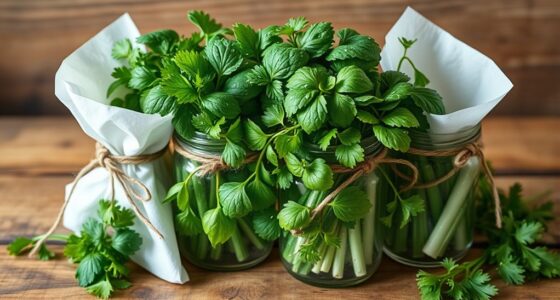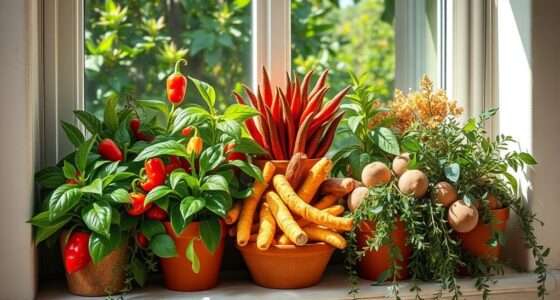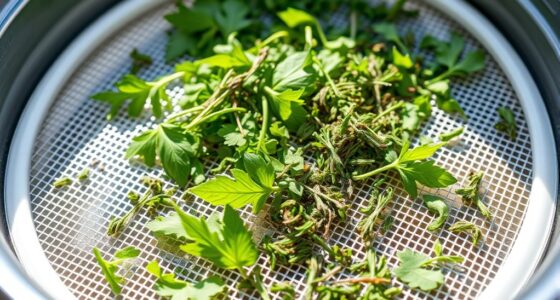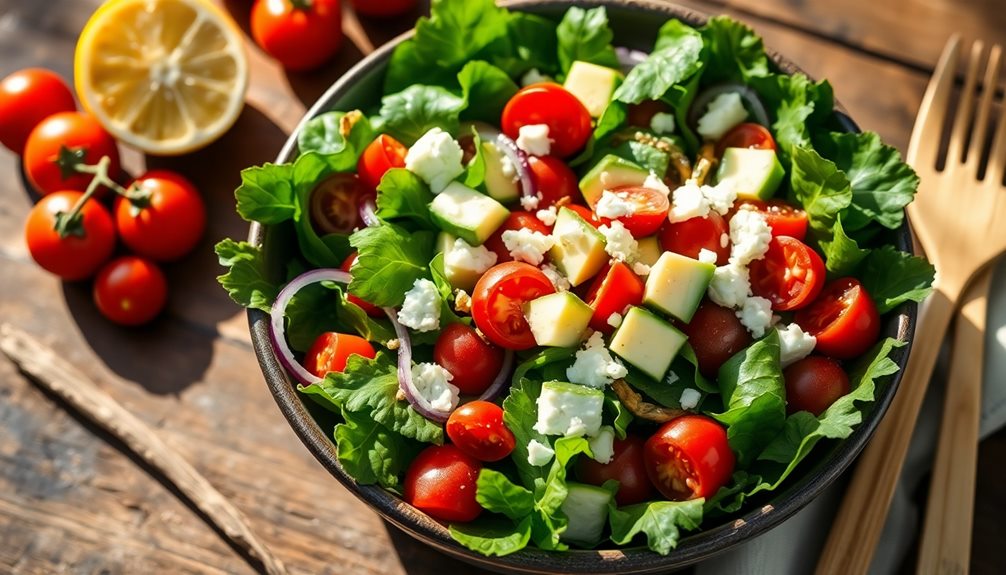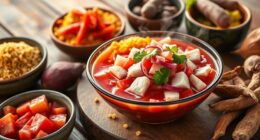To cook with fresh fall herbs like sage, rosemary, and thyme, start by selecting herbs with vibrant aroma and healthy leaves. Use them to enhance hearty dishes such as roasts, stews, or roasted vegetables. Harvest your herbs at the right time—preferably in the morning—and store them properly to maintain flavor. Incorporate these herbs generously, knowing their unique profiles will elevate your seasonal recipes. Keep exploring to unveil more tips on combining and maximizing their flavors.
Key Takeaways
- Choose herbs based on their flavor profiles: sage for hearty dishes, rosemary for roasted meats, thyme for stews and poultry.
- Harvest herbs in the morning after dew dries, using sharp scissors, to maximize flavor and plant health.
- Incorporate fresh herbs early in cooking to release their essential oils and enhance seasonal flavors.
- Dry or freeze herbs properly—air-dried in a cool, dry place or frozen in ice cubes—to preserve their aroma and potency.
- Use herbs like sage for stuffing, rosemary for roasted potatoes and lamb, and thyme for stews and sauces to complement fall dishes.
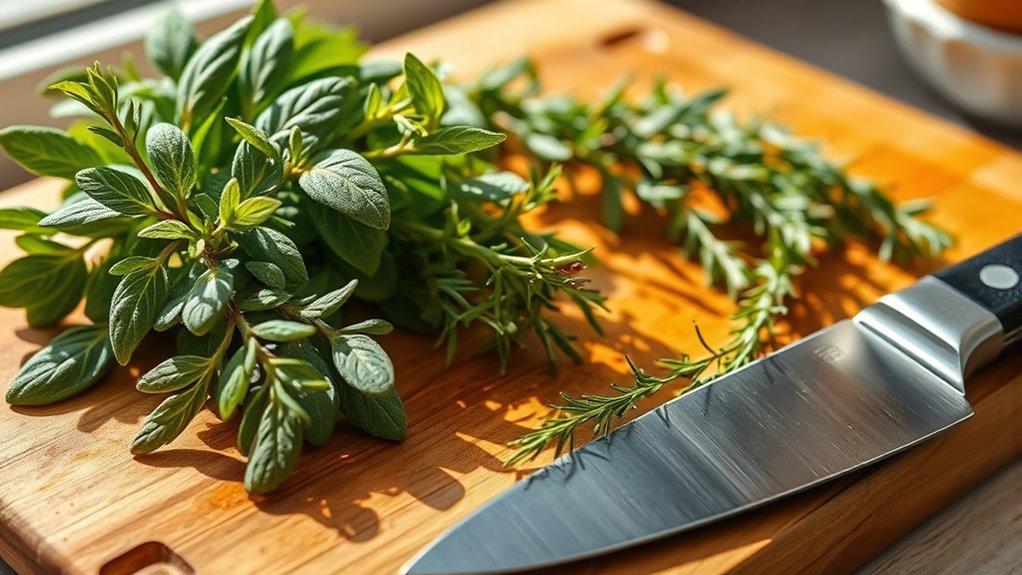
As fall arrives, it’s the perfect time to elevate your cooking with fresh seasonal herbs. These herbs—sage, rosemary, and thyme—bring robust, earthy flavors that perfectly complement the season’s hearty dishes. Understanding herb flavor profiles helps you select the right herbs for your recipes, while mastering harvesting and storing techniques guarantees you enjoy their freshest taste throughout the season.
Sage has a strong, slightly peppery flavor with hints of mint and eucalyptus, making it ideal for stuffing, roasted vegetables, and rich meats. Rosemary offers a piney, woody aroma with a hint of citrus, bringing depth to roasted potatoes, lamb, and fall soups. Thyme is more subtle, with dry, earthy notes that work well in stews, sauces, and poultry dishes. Recognizing these flavor profiles allows you to craft balanced, flavorful meals that highlight each herb’s unique qualities.
Sage, rosemary, and thyme each add distinct, seasonal flavors to elevate your fall cooking.
When harvesting your herbs, timing is essential. For sage, pick leaves in the morning after the dew has dried, when their oils are most concentrated. Use clean, sharp scissors or pruning shears to snip at the base, avoiding overharvesting that could weaken the plant. Rosemary can be harvested by cutting sprigs as needed, but always leave enough foliage so the plant remains healthy. Thyme is best harvested by snipping sprigs just above a set of leaves, which encourages new growth. Harvest herbs regularly to promote bushier growth and better flavor development.
Storing these herbs properly guarantees they retain their vibrant flavors longer. For sage and rosemary, you can hang small bundles upside down in a cool, dry place to air-dry, then crumble the leaves into jars or use fresh. Alternatively, you can freeze chopped herbs in ice cube trays with a bit of water or olive oil, then pop out portions as needed. Thyme is versatile; you can dry whole sprigs and keep them in airtight containers, or freeze chopped leaves in small portions. Always store herbs away from direct sunlight and moisture, which can degrade their essential oils and flavor.
Frequently Asked Questions
How Do I Store Fresh Fall Herbs to Maximize Shelf Life?
To maximize shelf life, store your fresh fall herbs properly by using herb drying techniques or storing herb bundles. Wrap the herbs loosely in a damp paper towel and place them in a plastic bag or container with ventilation. Keep them in the fridge’s crisper drawer. This method helps retain moisture and flavor, preventing wilting and decay, so you can enjoy your herbs longer.
Can I Use Dried Herbs Instead of Fresh in Recipes?
Yes, you can use dried herbs instead of fresh, but you should do a dried herb substitution, which means using less since dried herbs are more concentrated. Typically, substitute 1 teaspoon of dried herbs for 1 tablespoon of fresh herbs. Remember to adjust herb potency accordingly, as dried herbs have a stronger flavor. Add dried herbs earlier in the cooking process to allow their flavors to fully develop.
Are There Specific Herbs That Pair Best With Certain Meats?
You’ll find that certain herbs truly enhance specific meats through thoughtful herb flavor pairing and meat complement suggestions. For example, rosemary pairs beautifully with lamb and pork, offering earthy notes. Sage complements poultry and sausage with its robust aroma, while thyme works well with beef and chicken, adding subtle depth. Don’t shy away from experimenting—these combinations elevate your dishes and bring out the best in each meat, creating memorable meals.
How Do I Prevent Herbs From Overpowering a Dish?
To prevent herbs from overpowering a dish, you should start with small amounts and gradually add more, keeping herb potency in mind. Tasting as you cook helps maintain a balance of flavors, ensuring the herbs enhance rather than dominate. Use fresh herbs sparingly at first, then adjust. Remember, less is often more, and a well-balanced dish showcases the herbs without overwhelming the other ingredients.
What Are Creative Ways to Incorporate Herbs Into Desserts?
You can get creative by infusing herbs into your desserts, like making herb-infused chocolates or herb-flavored fruit compotes. Gently steep herbs such as thyme or rosemary in hot cream before incorporating it into your chocolate or pouring it over fruit. This adds a subtle, aromatic twist that enhances sweetness without overpowering. Experiment with small amounts first to find the perfect balance, and enjoy a unique, flavorful dessert experience.
Conclusion
Now that you know how to incorporate fresh fall herbs like sage, rosemary, and thyme into your cooking, don’t be afraid to experiment and make the most of their flavors. When you use herbs at their peak, your dishes will truly shine. Remember, the proof of the pudding is in the eating—so trust your taste buds and enjoy every bite. With a little practice, you’ll turn simple ingredients into something special.



